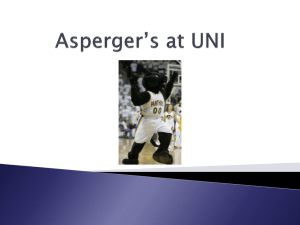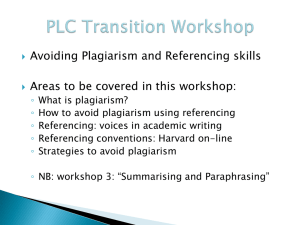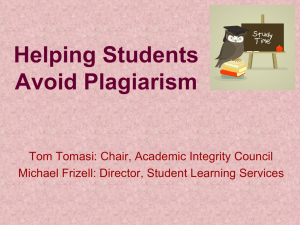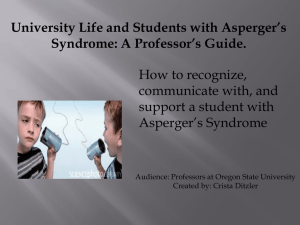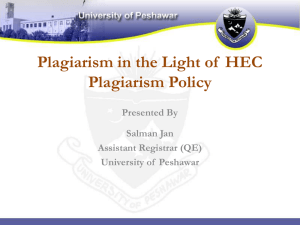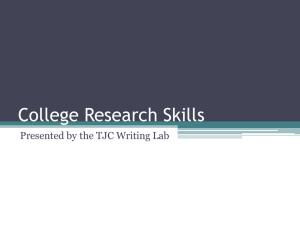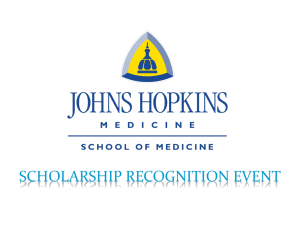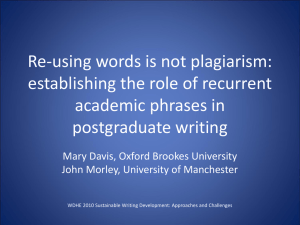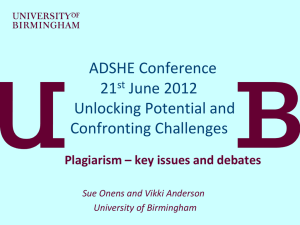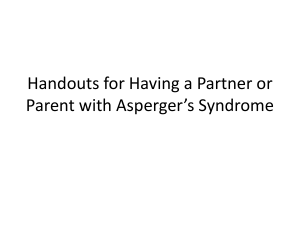Academic Scholarship & Plagiarism
advertisement
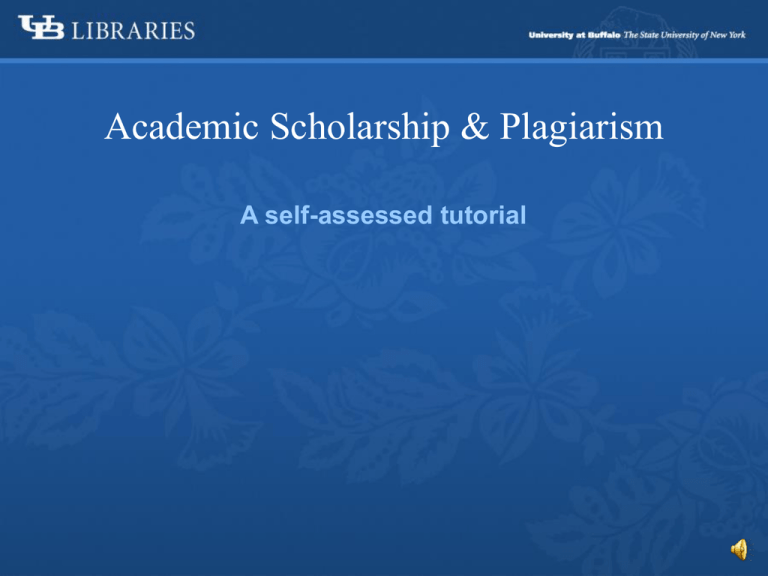
Academic Scholarship & Plagiarism A self-assessed tutorial What is academic scholarship? Academic writing is meant for a critical and informed audience, based on investigated knowledge, and uses hypothesis, theory, or arguments to arrive at a conclusion. It is objective, explains why the research is important, and organized so that other scholars can try to reproduce the results. Academic writing utilizes formal language. Who are the authors? Faculty Retired Faculty (Emeritus) Images from Microsoft Clip Art 2010 Who are the authors? Scientist Research Team Images from Microsoft Clip Art 2010 How is the research disseminated? Dissertations Books Journal Articles Academic scholarship: Books and dissertations go through a lengthy review process, sometimes taking years before they are ready for publication. The author has had his/her work reviewed by peers (fellow professors or researchers) and copy editors for both content clarity and grammar. Due to their length, books and dissertations are organized into chapters. They usually end with a final concluding chapter. Academic scholarship: Journal articles are slightly different. They go through a much shorter review process, anywhere from three months to one year. However, they are also reviewed by peers (scholars who are experts in the field of study) and journal editors. Because of their conciseness, they tend to follow a standard format. Academic scholarship in the social sciences: Journal articles in the social sciences typically include: Abstract Introduction Literature Review Hypothesis Methodology Results Discussion Conclusion Bibliography/References Let’s take a closer look at each section. Academic scholarship consists of: An abstract summarizes the important parts of the research. It gives the purposes of the research, the methodology used to collect data, and a brief conclusion. Academic scholarship consists of: A literature review goes through earlier research that has already been done on the topic. It may also review research that has been done on tangential or similar topics that support or even refute the author’s hypothesis. Academic scholarship consists of: After the literature review one usually finds a brief mention of the methodology to be used along with a detailed hypothesis for the research. What is being measured and why? What is the expected outcome and how will data be gathered? Academic scholarship consists of: The remainder of the article typically contains headings. The first is methodology. This is the method the researcher employed to test his/her hypothesis. Some common methods are: coded analysis of interactions, survey, or experiment. Academic scholarship consists of: Results follow the methodology. In this section you will find the author’s data along with an interpretation of the findings. Academic scholarship consists of: The discussion is next. Here the author will place his/her research within the larger body of knowledge on the topic. The author will also discuss the meaning behind the results in the previous section. Academic scholarship consists of: The last piece of the article is the Conclusion. Here the author summarizes the hypothesis as it pertains to the actual research results. Academic scholarship consists of: The References or Bibliography always appear at the very end. It is a list, alphabetical by author’s last name, of all the books, articles, dissertations, websites, etc. that were consulted and cited in writing the piece. Is this academic scholarship? Multimedia Connections (Click the link to open a new window. When you are done viewing close it to return to the tutorial) Answer Yes This is an academic article, hosted on a non-profit organization’s website. Permission to reprint the article online was given by the author. It contains an abstract, introduction, literature review, hypothesis, methodology (case study), discussion, and bibliography. What is Plagiarism? Oxford English Dictionary defines plagiarism as: The action or practice of taking someone else's work, idea, etc., and passing it off as one's own; literary theft. Had I not told you where the definition came from I would have been guilty of plagiarism. Avoiding plagiarism: In the body of your paper Provide proper citations for all quotations, summaries, paraphrases, or any other work or idea that is borrowed from others. Specific formatting styles are used depending on your discipline. The most common are MLA (Arts & Humanities) and APA (Social Sciences). Avoiding plagiarism: In the body of your paper Using quotations When using exact words, phrases, or sentences from a source, make sure to properly use quotation marks and cite where the information was taken from. Avoiding plagiarism: In the body of your paper Here is an example (using APA style) Asperger's Syndrome (AS) was first proposed in 1944 by Hans Asperger, an Austrian psychiatrist who described in his paper, Die Autistischen Psychopathen a condition which was characterized by “pedantic and stereotyped speech patterns, clumsiness, obsessional interests and deficient social behavior” (Goble, 1995). This author has quoted Goble’s 1995 article; note the quotation marks. Avoiding plagiarism: In the body of your paper Here is another example (using MLA style) As Temple Grandin, a woman who has Asperger’s syndrome who has become a successful engineer, author, and academic, said, “If the world was left to you socialites, we would still be in caves talking to each other” (Personal interview). This author has quoted a personal communication between him/herself and another person; note the quotation marks. Avoiding plagiarism: In the body of your paper Summarizing & Paraphrasing Paraphrasing is when you take the ideas or phrases from a source and rewrite them using your own words. Summarizing is condensing a source into a few lines, focusing on the author’s main points. In both cases, credit is given to the original author or authors. Avoiding plagiarism: In the body of your paper Here is an example (using MLA style) As Rieber suggests, children are wired to learn through their own play, that play is children's work and that the transmission model of teaching where the teacher is the omniscient conduit of a generally recognized and approved body of information, is no longer appropriate (45). This author has paraphrased the 4th paragraph on page 45 of Rieber’s article. Avoiding plagiarism: In the body of your paper Here is another example (using APA style) In terms of qualitative differences, however, researchers agree that children with autism are less likely to display positive affect and/or more likely to display negative affect than typically developing children (Dawson, Hill, Spencer, Galpert, & Watson, 1990; Snow et al., 1987; Yirmiya et al., 1989). Here the author summarized the findings of three articles (each written by multiple authors) to come to this one point. Let’s Pretend You are a student writing a paper. You have gathered literature on your paper topic, Asperger’s syndrome. In the following questions you will be asked to review parts of what you have “read”, look at what you have “written”, and determine if you are plagiarizing. In the book The Complete Guide to Asperger’s Syndrome by Tony Attwood (2007) on page 56 you read. The phrase ‘two’s company, three’s a crowd’ is very appropriate for someone with Asperger’s syndrome. In a group setting, the person’s intellectual capacity may not be sufficient to cope with the social interaction of several participants, and the person may take longer to process social information that is normally communicated more quickly in a group than individually. If a one-to-one conversation is a game of tennis, a group interaction is a game of football. In your paper you write: In a group setting, the person’s intellectual capacity is such that a person with Asperger’s syndrome does not have the intellectual capacity to cope with a social interaction of several participants. They may take longer to process social information (Attwood, 2007). Is it plagiarism? Answer Yes It is plagiarism because you used too many of Tony Attwood’s original words. In a group setting, the person’s intellectual capacity is such that a person with Asperger’s syndrome does not have the intellectual capacity to cope with a social interaction of several participants. They may take longer to process social information (Attwood, 2007). Instead paraphrase: According to Attwood (2007), the more participants in a social interaction the more likelihood a breakdown in the transmission of social information will occur for a person with Asperger’s syndrome. On the Internet you find: Asperger’s Syndrome Fact Sheet. (Click the link to open a new window. When you are done viewing close it to return to the tutorial) In your paper you write: According to the National Institutes of Health (2010), Asperger’s syndrome is characterized by repetitive routines, peculiarities in speech and language, socially and emotionally inappropriate behavior, restricted use of gestures, and uncoordinated motor movements. Is it plagiarism? Answer No This is acceptable quoting. The name of the organization and the year accessed is included at the beginning of the sentence. It would also be included in the bibliography with the name of the page, date accessed, and URL. You digitize the following table from a book found at Google Books: During your in-class Power Point presentation you include table 15.1 as it is. Is it plagiarism? Answer Yes This is plagiarism. Even though it is not being published it is still being viewed by others. Therefore, the author needs to receive credit for his work and you need to let the audience know that this is not your intellectual property by including a footnote below the table. You know it’s a well-established fact that some famous people have suffered from Asperger’s Syndrome. In your paper you write: Current Asperger’s syndrome (AS) research has discovered that adults with AS have a remarkable ability to become completely focused on one topic, to the exclusion of all else. This ability to block out the mundane world has lead psychologists to hypothesize that many artists and scientists have Asperger’s syndrome. It is a well-established fact that Andy Warhol and Albert Einstein were living with AS before it was known. Is it plagiarism? Answer Yes This is plagiarism. This “well-established fact” needs to be verified, the author or authors found, and a proper citation inserted. Avoiding plagiarism: In your bibliography In your paper you will cite the books, articles, dissertations, videos, etc. that you used either as footnotes at the bottom of each page or as a bibliography at the end. The choice will be made either by your instructor or by the citation style you use. Avoiding plagiarism: In your bibliography The University Libraries have an excellent guide to the most popular citation styles here, Citing Sources. Avoiding plagiarism: In your bibliography Here are some examples - Website APA National Institute of Neurological Disorders and Stroke (2010, November 10). Asperger’s Syndrome Fact Sheet. Retrieved from http://www.ninds.nih.gov/disorders/asperger/detail_asperger.htm. MLA “Asperger’s Syndrome Fact Sheet.” National Institute of Neurological Disorders and Stroke. Web. 10 Nov 2010. <http://www.ninds.nih.gov/disorders/asperger/detail_asperger.htm.> Avoiding plagiarism: In your bibliography Here are some examples - Book APA Attwood, T. (2007). The complete guide to Asperger’s syndrome. Philadelphia:Jessica Kingsley Publishers. MLA Attwood, Tony. The complete guide to Asperger’s syndrome. Philadelphia:Jessica Kingsley Publishers, 2007. Print. Avoiding plagiarism: In your bibliography Here are some examples - Article APA Muller, E. & Schuler, A. (2006). Verbal Marking of Affect by Children with Asperger Syndrome and High Functioning Autism during Spontaneous Interactions with Family Members. Journal of Autism & Developmental Disorders, 36(8), 1089-1100. MLA Muller, Eve. & Schuler, Adriana. “Verbal Marking of Affect by Children with Asperger Syndrome and High Functioning Autism during Spontaneous Interactions with Family Members.” Journal of Autism & Developmental Disorders 36.8 (2006): 1089-1100. Print. UB’s Plagiarism Policy “Written works must be the complete and original effort of the student, with all ideas and words of others duly attributed according to the appropriate style manual. Furthermore, students should not recycle work in subsequent courses, nor should they facilitate any act of academic dishonesty by another person. If in doubt, the student should err on the side of caution and consult the instructor for additional guidance.” From, UB Academic Integrity Policies. Accessed on November 10, 2010. http://academicintegrity.buffalo.edu/policies/index.php How is the policy enforced? UBlearns utilizes the SafeAssign™ plagiarism detection software tool. This enables students and faculty to submit papers through UBlearns to detect whether passages – or even entire papers – are directly copied from original sources. The uploaded papers are checked against several databases and the Internet. Thank you for taking this self assessment. For more help: Research Tips Citing Sources Subject Librarian University at Buffalo Libraries
